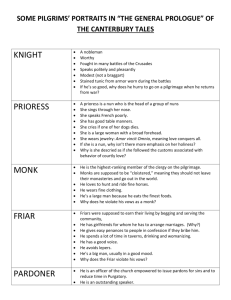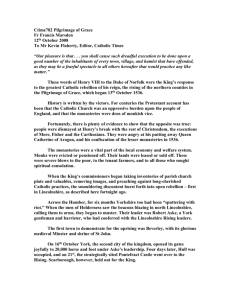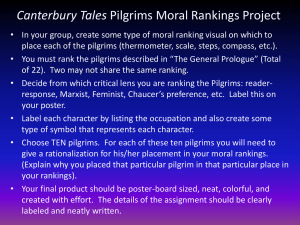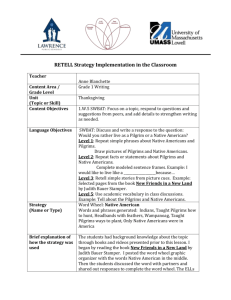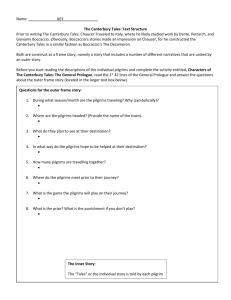A Pilgrimage to Mount Athos Chapter 1 Introduction “Have you had a
advertisement
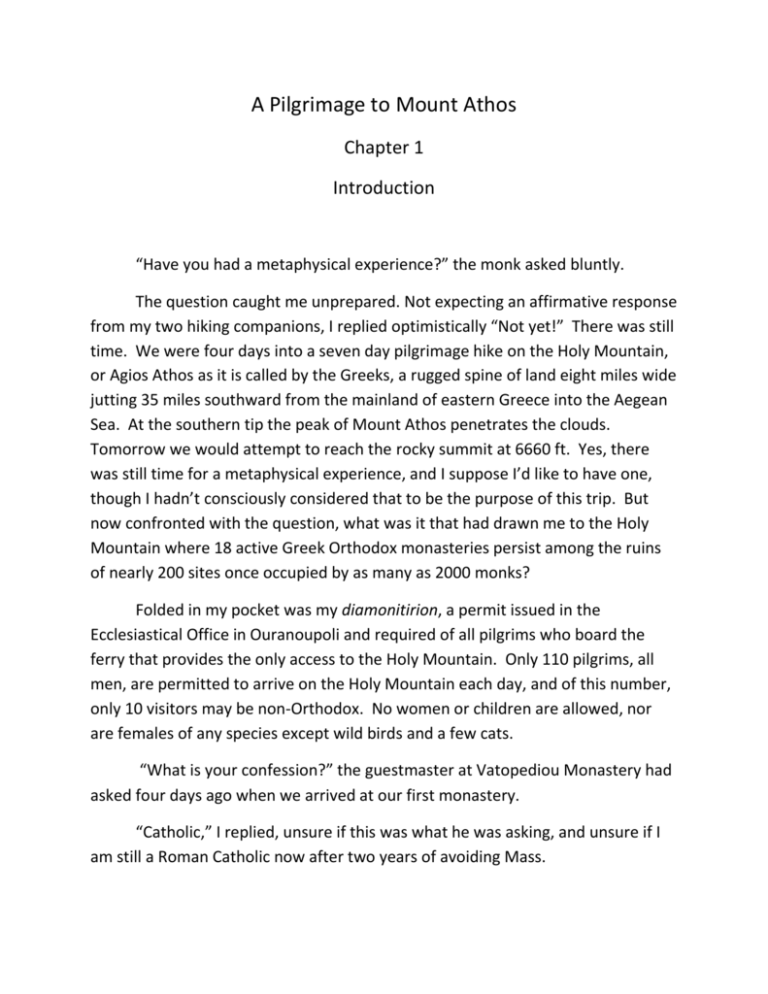
A Pilgrimage to Mount Athos Chapter 1 Introduction “Have you had a metaphysical experience?” the monk asked bluntly. The question caught me unprepared. Not expecting an affirmative response from my two hiking companions, I replied optimistically “Not yet!” There was still time. We were four days into a seven day pilgrimage hike on the Holy Mountain, or Agios Athos as it is called by the Greeks, a rugged spine of land eight miles wide jutting 35 miles southward from the mainland of eastern Greece into the Aegean Sea. At the southern tip the peak of Mount Athos penetrates the clouds. Tomorrow we would attempt to reach the rocky summit at 6660 ft. Yes, there was still time for a metaphysical experience, and I suppose I’d like to have one, though I hadn’t consciously considered that to be the purpose of this trip. But now confronted with the question, what was it that had drawn me to the Holy Mountain where 18 active Greek Orthodox monasteries persist among the ruins of nearly 200 sites once occupied by as many as 2000 monks? Folded in my pocket was my diamonitirion, a permit issued in the Ecclesiastical Office in Ouranoupoli and required of all pilgrims who board the ferry that provides the only access to the Holy Mountain. Only 110 pilgrims, all men, are permitted to arrive on the Holy Mountain each day, and of this number, only 10 visitors may be non-Orthodox. No women or children are allowed, nor are females of any species except wild birds and a few cats. “What is your confession?” the guestmaster at Vatopediou Monastery had asked four days ago when we arrived at our first monastery. “Catholic,” I replied, unsure if this was what he was asking, and unsure if I am still a Roman Catholic now after two years of avoiding Mass. “It says here you are Protestant,” he said, pointing to a line of Greek letters, undecipherable to me on my diamonitirion. “I was a Protestant until I married a Catholic and then I became a Catholic. Is that OK?” “That is not a problem,” he smiled reassuringly. My companions, both Protestants, at least on paper, were listening. Obviously, we were not Orthodox. Nor were we typical pilgrims who are short thick men 50 to 60 years old with olive skin, dark hair, and stubby fingers on meaty hands. They wore comfortable casual leather shoes, slacks or jeans, shirts with buttons, and a light jacket. A few were in their thirties and forties, not yet rotund nor receding. Nearly all pilgrims had arrived much earlier by a 30 minute bus ride from Karyes, the administrative capital situated centrally on the peninsula. Upon entering the arhontariki (the guest house) they had been given the traditional welcome; a glass of water, a shot of raki (an alcoholic spirit strong enough to evoke visions), a tiny cup of Greek coffee, and a cube of Turkish delight dusted with confectionary sugar. The three of us arrived too late for these amenities after a 6 hour, 7 mile hike from Karyes along narrow footpaths through the mountain forests. We stood there before the guestmaster, faces grimy, shoulders sore from bearing backpacks, shirts and pants sweat-soaked and smelly, hiking boots dusty from the trail. No doubt about it. We were not the usual pilgrims. I had studied those pilgrims during nearly two hour ferry trip from Ouranopoli to Dafni. In looks and demeanor, they were ordinary men. Some were boisterous and animated, gesturing and laughing as they argued some issue or engaged in banter with their fellow travelers. Others sat in quiet contemplation. Some sipped Amstel beer from bright red and yellow cans. Others nodded off, succumbing to serenity of the warm air and bright June sun and blue waters of the Mediterranean Sea. What had they in common? Was it a desire to escape the toil of everyday life and the stress of work and family? Were they seeking a spiritual experience, rejuvenation, rededication, rest, relaxation? Most gathered at the railings as monasteries came into view along the coastline. I joined them there. Together we politely jostled for good camera angles, they with their point-and-shoots and me with my bulky SLR and interchangeable lenses. Maybe we were seeking similar things, similar experiences, though by different means. Already we had sharply distinguished ourselves from other pilgrims. The monk at the guestmaster’s desk had greeted us formally with a phrase highly religious in tone but one I did not recognize. Had he used the Roman Catholic greeting “The Lord be with you,” I could have confidently replied “And also with you,” thereby instantly identifying myself as a fellow Catholic who shares a set of beliefs. Instead, I fumbled for something to say, realizing that my response instantly revealed that I was an outsider and quite possibly apostate. The guestmaster at Vatopediou continued his gentle questioning. “Is this your first visit to Holy Mountain?” “Yes,” we replied in unison. “And what are your names and occupations?” “I’m Peter Schmunk,” my colleague began. Peter had organized this trip. He explained that all three of us are professors at Wofford College, a small liberal arts college of about 1350 students in Spartanburg, South Carolina. “Where is South Carolina?” the monk pondered. “In the southeastern United States, near Atlanta,” Peter said. “Ah, close to Florida,” the monk guessed. “Yes,” Peter said. He continued the introduction by stating that he is a professor of art history with a strong interest in Renaissance art, especially painting and architecture. He teaches a variety of courses in Art History and has recently grown more fascinated with Byzantine art. He has long known that the Mount Athos peninsula, a World Heritage Site, is a fabulous repository of Byzantine fresco and icon paintings and has studied pictures and read descriptions of the buildings comprising the monasteries and hermitages. He explained that all three of us share a love of art, a passion for photography, and a fondness for outdoor adventure. We expect this pilgrimage hike to allow us to simultaneously enjoy all those things while learning more about the Orthodox faith and monastic life. Peter described our intent to hike the trails that weave across ridges and through ravines, connecting the monasteries where he had made reservations months for us months in advance. Only one day into this adventure, we were already aware that nearly all pilgrims travel by bus on dirt roads to visit a series of monasteries. We had encountered perhaps three men during our 8 mile hike from Karyes to Vatopediou. “I was chemist for most of my career,” added Dave Whisnant “but now I’m an administrator responsible for computers at the college.” Dave is 65 years old and worries that the limitations of his aging body may soon prevent him from physical challenges of this nature. At age 51, I have those same concerns although I managed today’s trails without my usual knee braces. “I’m a biologist,” I spoke in turn. The guestmaster nodded in approval and amusement. “Yes,” he said “the diamonitiria indicate that you are professors. What an interesting combination. We have many visitors who are interested in art, but it is rather unusual to have a chemist and biologist visit Holy Mountain. Most scientists are cynical in matters of religion.” “Many of our colleagues are,” I offered, hoping that further explanation, including an expression of my personal views would not be required. “Well, we are happy to have you as guests,” he concluded. “I will tell you about our simple rules before I show you to your room. Pictures are not allowed. You must dress appropriately at all times. No shorts. No bare feet. Not even as you go from your room to the showers at the end of the hall. You will hear the simandro at 3:30 in the morning. Matins begins at 4 a.m. in the katholicon. At the services you may sit in the first room only. You need not attend the entire worship which concludes at about 7 am. You are free to come as early as you wish and stay as long as you like. You have had a long hike today. Maybe you will need to sleep later in the morning. If so, someone will come by your room at 6:30 to wake you. Breakfast is served in the trapeza shortly after the service ends. You will take your meals there with the monks and pilgrims. There is no talking during the meal. A monk will read from the scripture or the life story of a saint while you eat. The meal ends when the reading ends and a bell rings. You will immediately rise and wait for the monks to process out and then you will follow. Afterwards you may join the pilgrims on a tour of the church. At that time you may venerate the holy relics.” Even though Peter and Dave had learned about the monastic routine by reading guidebooks and the webpages of men who had written accounts of their experiences here, we were relieved to have some clarification of the schedule and what was expected of us. The guestmaster, who by now had demonstrated a mastery of the English language easily surpassing my own, had managed to make us feel warmly welcomed. He rose from his desk to lead us to our room. We shouldered our backpacks and followed him down a long wide hallway with high ceiling and gleaming wood floor. He opened a door to a room furnished with three low single beds, a large window with a view across the courtyard to the katholicon (monastic church), and a large elaborate fixture occupying an entire corner the might have been a shrine or altar. “You will find the toilets and a shower at the end of the hall through a door to the left,” he motioned. “Enjoy your stay,” he said, ever the gracious host. We thanked him profusely as he left us. I collapsed on the bed by the window, too exhausted by the strenuous hike from Karyes to do anything else. Perhaps a vivid metaphysical experience was just what I needed to rejoin the ranks of the apostolate. But on the fourth day of my pilgrimage, there had been no metaphysical experience. At least, not yet!
